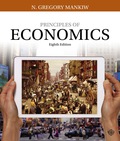
EBK PRINCIPLES OF ECONOMICS
8th Edition
ISBN: 8220103600453
Author: Mankiw
Publisher: CENGAGE L
expand_more
expand_more
format_list_bulleted
Question
Chapter 32, Problem 4PA
To determine
The impact of reduction in the trade barriers.
Expert Solution & Answer
Want to see the full answer?
Check out a sample textbook solution
Students have asked these similar questions
not use ai please
Fems A and B are duopolist producers of widgets. The cost function for producing widgets
C(Q)-Q²
The market demand function for widgets i
Q-192P
Qmeasures thousands of widgets per year, Competition in the widget market is described by the Coumot model
Instructions: Round your answers to 2 decimal places
a What are the firms' Nanh equbrium output?
b. What is the resulting price?
c. What do they each emp
How does the price compare to marginal cost?
Price is ck to marginal cost
How do the price and the two fems' joint profit compare to the monopoly price and prof
Compared to the monopoly price, the Cournot price is to sed. Compared to the monopoly profit, the joint profit of the two
fems to select
Suppose the marginal social cost of television sets is $100. This is constant and equal to the average cost of television sets. The annual demand for television sets is given by the following equation: Q = 200,000-500P, where
Qis the quantity sold per year and P is the price of television sets. a) If television sets are sold in a perfectly competitive market, calculate the annual number sold. Under what circumstances will the market equilibrium be
efficient? b) Show the losses in well-being each year that would result from a law limiting sales of television sets to 100,000 per year. Show the effect on the price, marginal social benefit, and marginal social cost of television
sets. Show the net loss in well-being that will result from a complete ban on the sales of television sets. (show with graphs.)
Knowledge Booster
Similar questions
- refer to exhibit 8.12 and identify each curve in the grapharrow_forwardQ1. (Chap 1: Game Theory.) In the simultaneous games below player 1 is choosing between Top and Bottom, while player 2 is choosing between Left and Right. In each cell the first number is the payoff to player 1 and the second is the payoff to player 2. Part A: Player 1 Top Bottom Player 2 Left 25, 22 Right 27,23 26,21 28, 22 (A1) Does player 1 have a dominant strategy? (Yes/No) If your answer is yes, which one is it? (Top/Bottom) (A2) Does player 2 have a dominant strategy? (Yes/No.) If your answer is yes, which one is it? (Left/Right.) (A3) Can you solve this game by using the dominant strategy method? (Yes/No) If your answer is yes, what is the solution?arrow_forwardnot use ai pleasearrow_forward
- subject to X1 X2 Maximize dollars of interest earned = 0.07X1+0.11X2+0.19X3+0.15X4 ≤ 1,000,000 <2,500,000 X3 ≤ 1,500,000 X4 ≤ 1,800,000 X3 + XA ≥ 0.55 (X1+X2+X3+X4) X1 ≥ 0.15 (X1+X2+X3+X4) X1 + X2 X3 + XA < 5,000,000 X1, X2, X3, X4 ≥ 0arrow_forwardnot use aiarrow_forwardPlease help and Solve! (Note: this is a practice problem)arrow_forward
- Please help and thanks! (Note: This is a practice problem!)arrow_forwardUnit VI Assignment Instructions: This assignment has two parts. Answer the questions using the charts. Part 1: Firm 1 High Price Low Price High Price 8,8 0,10 Firm 2 Low Price 10,0 3,3 Question: For the above game, identify the Nash Equilibrium. Does Firm 1 have a dominant strategy? If so, what is it? Does Firm 2 have a dominant strategy? If so, what is it? Your response:arrow_forwardnot use ai please don't kdjdkdkfjnxncjcarrow_forward
- Ask one question at a time. Keep questions specific and include all details. Need more help? Subject matter experts with PhDs and Masters are standing by 24/7 to answer your question.**arrow_forward1b. (5 pts) Under the 1990 Farm Bill and given the initial situation of a target price and marketing loan, indicate where the market price (MP), quantity supplied (QS) and demanded (QD), government stocks (GS), and Deficiency Payments (DP) and Marketing Loan Gains (MLG), if any, would be on the graph below. If applicable, indicate the price floor (PF) on the graph. TP $ NLR So Do Q/yrarrow_forwardNow, let us assume that Brie has altruistic preferences. Her utility function is now given by: 1 UB (xA, YA, TB,YB) = (1/2) (2x+2y) + (2x+2y) What would her utility be at the endowment now? (Round off your answer to the nearest whole number.) 110arrow_forward
arrow_back_ios
SEE MORE QUESTIONS
arrow_forward_ios
Recommended textbooks for you





 Economics (MindTap Course List)EconomicsISBN:9781337617383Author:Roger A. ArnoldPublisher:Cengage Learning
Economics (MindTap Course List)EconomicsISBN:9781337617383Author:Roger A. ArnoldPublisher:Cengage Learning






Economics (MindTap Course List)
Economics
ISBN:9781337617383
Author:Roger A. Arnold
Publisher:Cengage Learning